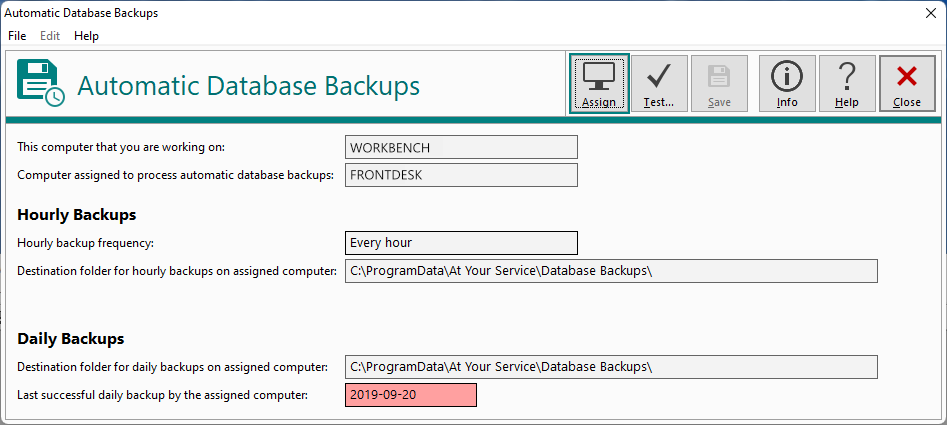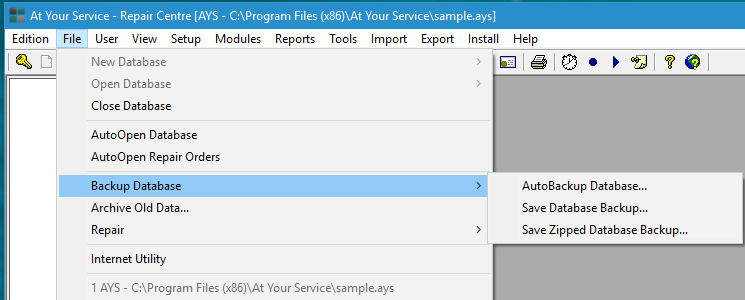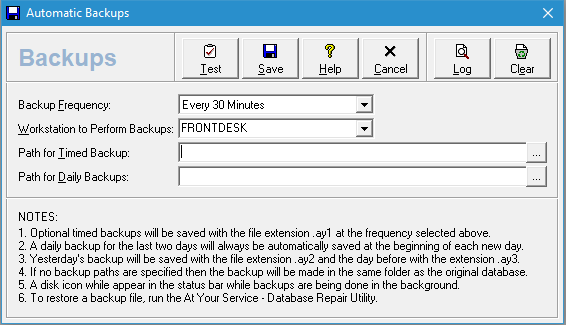At Your Service provides some automatic means for database backup, and you can choose typical backup strategies to improve the security of your data.
Database Backup Options
Open your database. Under the File menu you will see a “Backup Database” option. You can choose here to:
- Configure automatic database backups
- Save a non-compressed database backup
- Save a compressed (zipped) database backup
Regular Full Backups
In addition to the automatic backup described below, you should add your database files to your typical backup routine. Since AYS databases are self-contained, you can simply copy the .ays files (and optionally the .aysdbb1, .aysdbb2, and .aysdbb3 files) to another medium, like a network server, a USB drive, and/or an online storage location.
You can make an on-demand backup at any time by using File > Backup Database > Save Database Backup or File > Backup Database > Save Zipped Database Backup. You will be prompted for a location to save the resulting file.
SQL Backup
If you are using a SQL server, the option for automatic timed backup is unnecessary and is disabled. You may still export data on-demand as .ays files (zipped or not) as described under “Regular Full Backups” above.
Your regular SQL server backup strategy can be used to back up the databases directly and is described here.
Automatic Database Backup
Automatic database backup has been updated as of the 2022 September release of AYS. Select the version you are currently using to see how to configure.
September 2022 release and later
You must assign a principal machine that will take the backups regularly through the day. In this screenshot, note that the current machine (WORKBENCH) and the assigned machine (FRONTDESK) are different, and all of the fields are read-only.

If you wish to assign the current computer to do the backups, click the “Assign” button.
The destination folder fields refer to the drive on the assigned computer. You will need to be at that computer to see or manage the backup files.
Assign a workstation that will most often be powered on and running AYS throughout the day so that the backup will actually take place.
You can change hourly backup frequency from “Never” (not recommended) all the way up to 8 hours. You can try to find a balance between potential data loss and network and system load.
If you are the assigned computer for backups, you will see two additional buttons to the right of the fields. These buttons let you choose a new backup location or view the current backups. If you are on a different machine on the network, you will not see these buttons, as they point to the file locations on the assigned machine.
The backup files are named with extensions based on the backup age and type:
- .aysdbb1 is the latest hourly backup
- .aysdbb2 is the last backup from the previous day
- .aysdbb3 is the last backup from the day before
Once you assign a computer to do the regular backups, all other workstations will defer to that machine. If you replace or decommission that machine, the automatic backups may not happen. At the bottom of the screen you will see a date when the last automatic backup has taken place. If this is quite old, you may toast notification in the corner of your screen like this:
You may also see the following toast message at the same time:
This ensures that the daily backup will take place, even if the older, assigned computer is no longer available on your network or logged into AYS. As soon as possible you should assign a computer that is in active use to manage the hourly backups.
The automatic backup mechanism is designed as a low-impact, lightweight data backup, but it should not be your only database backup solution.
Versions before 2022 September release
The first option in the backup screen sets how often the database will be backed up throughout the day. You can configure your frequency from 5 minutes to 8 hours.
The default, recommended backup frequency is 30 minutes. If you raise this value too high, less of your current data will be backed up, and if you lower it too far you will place unnecessary stress on your network and system resources.
Select the workstation to run the backup task.
Choose a workstation that will most often be powered on and running AYS throughout the day so that the backup will actually take place.
As the time elapses, the selected workstation will copy your currently running database to a backup file and named with an “.ay1” extension. If there is an existing file with that filename and extension, it will be replaced so that there is only one copy. The “.ay1” file will always be the most recent backup copy of your database.
If you leave the path boxes empty (as above) the backups will be placed in the same location as the database file.
At the start of each day, the .ay1 file will be renamed to .ay2, and any .ay2 file will be renamed .ay3. This provides you with an end-of-day backup for two previous work days.
You can identify the files in the file system by the extension, the icon (a red outline with a left-facing arrow) and the description.
If you have not configured automatic backup, or the workstation is unavailable, you will see this icon in the AYS status bar. Your database is not being periodically backed up.
The automatic backup mechanism is designed as a low-impact, lightweight data backup, but it should not be your only database backup solution.
0 people found this article useful
0 people found this article useful






